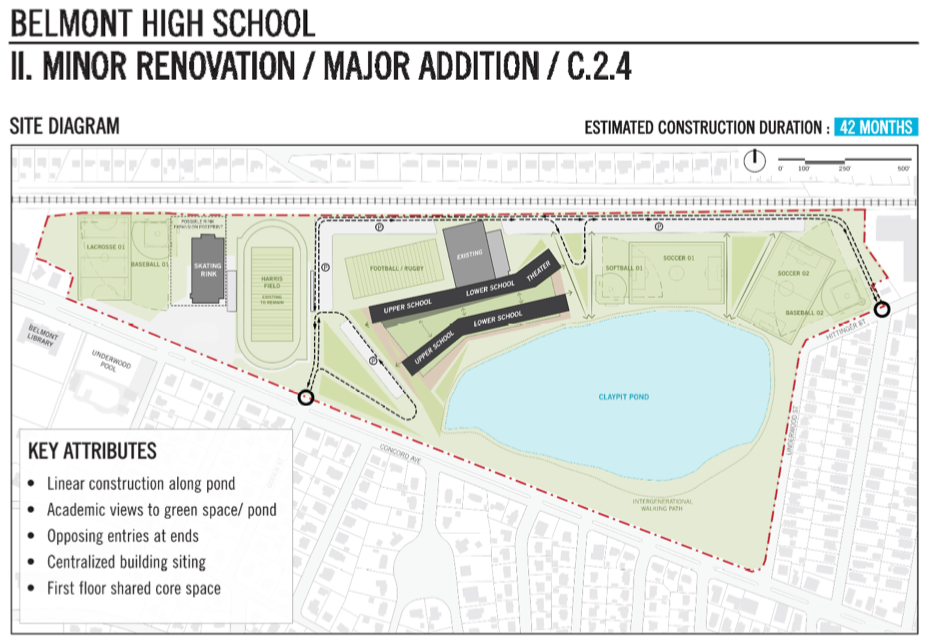Photo: The initial design of a new Belmont High School that is trending
Some say it looks like a bow tie. Others see the “X” of the chromosome structure. Whichever shape it’s called, the design designated as “C.2.4” by the architectural firm Perkins + Will of about a dozen preliminary designs for a new Belmont High School has caught the fancy of many leading that effort.
While it’s premature for the town to point to one specific plan as what will replace the nearly 50-year-old structure across from Clay Pit Pond, the groups are ramping up their public sessions as they move towards the ultimate selection of the new school’s grade configuration and basic design which is scheduled to take place on Jan. 23, 2018.
“We have a limited time to do this work and tonight we pick an opportunity to get the juices flowing; what’s really cool, what’s working,” said Bill Lovello, the chair of the Belmont High School Building Committee, which held a joint meeting on Nov. 30 with the Belmont Board of Selectmen and School Committee to meet with Perkins + Will and the Owner’s Project Manager Daedalus Projects, Inc. to debate and review a series of designs of revamping the current high school, from simple renovations, major and minor additions to complete new construction.
The initial reaction by the joint group highlighted two important “trends” according to Lovello; the grades to be housed in the new school and some general idea what it will look like.
While the numbers are still be calculated by the Belmont School District, the current direction among school officials and building committee members is the new school will house approximately 2,215 7th to 12th graders. While the high school’s grade configuration could continue with a traditional 9th- to 12th-grade building or an 8th to 12th layout, the preference from the school department has been for the larger grouping as it will effectively answer space issues created by skyrocketing enrollment in the Belmont district.
According to studies by the school department, a 9th to 12th school would require Belmont to build a new elementary school, an unlikely proposition due to the lack of suitable land, time and cost. An 8th to 12th would necessitate renovations at the middle school and the purchase of modular units to house the expanding student population.
The second trend is the “look” of the new school. Some designs, while they will be submitted to the state, are not going anywhere fast including the concept of building a new school adjacent Harris Field, that was dismissed with a barrage of catcalls from the meeting’s participants. But one particularly linear draft has caught the eye of many.
While the architects call the design a “minor renovation/major addition,” the “bow tie” design is essentially a new building that preserves and incorporates two elements from the existing high school; the Wenner Field House and the Higgenbottom Pool. During discussions of the designs, there was near majority opinion that the two athletic elements were important to save.
“It’s not an addition, it’s a new building,” said Daedalus Projects’ Thomas Gatzunis, the building committee’s owner’s project manager.
As for the design going by “bow tie” moniker, the 451,575 gross square foot campus will be segmented off into an upper and lower school much like the current arrangement at the Chenery Middle School. This will include separate entries for older and younger students. There will be areas that all students will interact such as athletics, a media center and “lunch” space. The space between the north and south wings will be administrative offices and a large cafeteria/open area.
The academic classrooms will overlook Clay Pit Pond, providing a southern exposure that will allow maximum use of natural light. Parking will be situated around the school with the necessity to move the Brendan Grant Field to another location.
“I think you get a much more impactful and better land use if you go with 2.4. That’s a very good starting point,” said Joseph DeStefano, a member of the building committee and real estate developer.
One major issue not discussed by anyone on the design team was the final price tag hanging off the project that residents will pay 60 percent of the cost through a debt exclusion, with 40 percent taken up by the Massachusetts School Building Authority.
The project will take three-and-a-half years (42 months) to build with the upper school – housing the current high school students – to be constructed first as the seventh and eighth graders will continue to attend the Chenery until the remainder of the school is constructed.
“It’s a win-win; you get brand new academic areas and … it’s efficient. So you end up with brand new buildings and renovated recreation space,” said Gatzunis.
While the design is trending as the favorite among the groups, the school’s final shape and location are far from set, according to Brooke Trivas, one of Perkins + Will’s project architects.
“We can nuance these options … that should be at the forefront of your [thinking],” Trivas said. “It might be a smaller size, will it be restoration or other designs. We have time to do that [to the design].”










Leave a Review or Comment